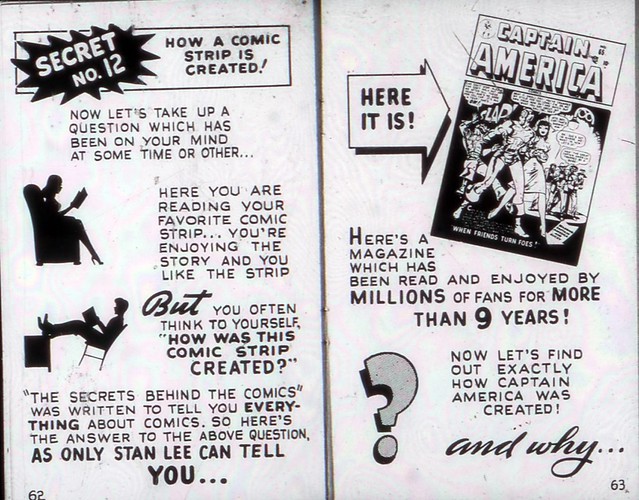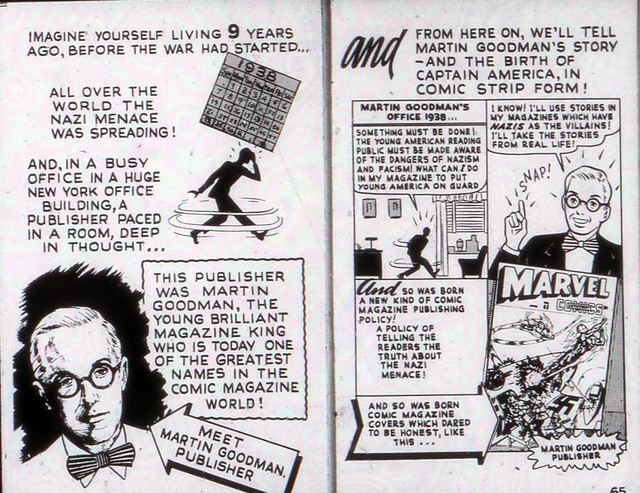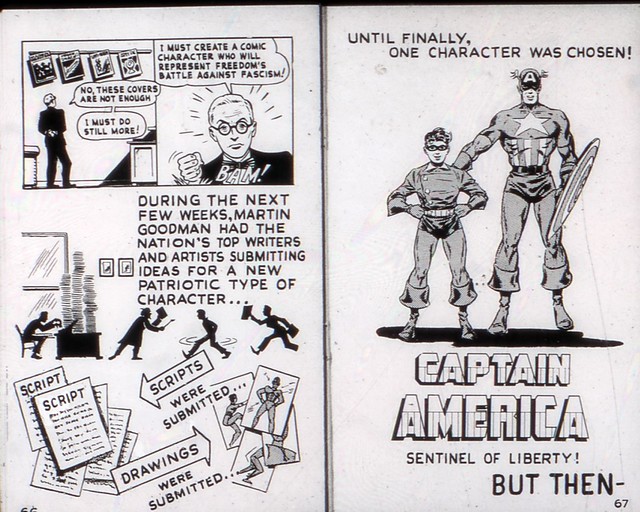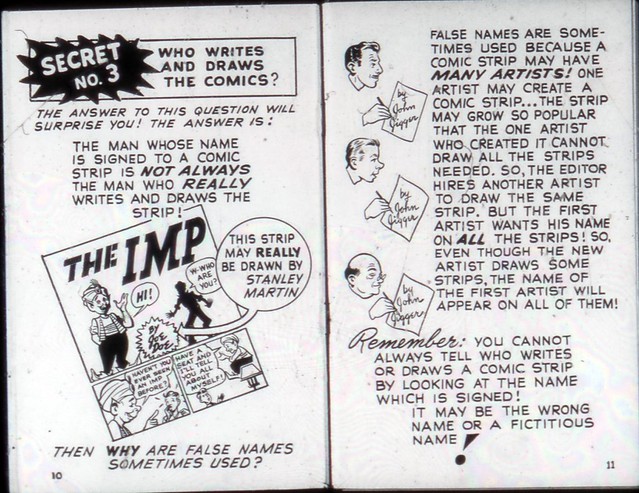|
|
Post by tolworthy on Feb 27, 2016 3:28:48 GMT -5
This may seem a simple question, suitable for the quick questions thread, but I'm looking for more detail, if anybody knows. We are all familiar with Joe Simon's account. This is from Wikipedia: That's how I always understood it. Joe Simon had the idea, and Jack Kirby drew it (which of course involved adding all the detail, hence they are co-creators). But I just read Stan Lee's "Secrets Behind the Comics" published in 1947. In it, Stan makes it sound like every idea that mattered was down to Martin Goodman.     This approach is clear throughout the book: Stan considers the editor to be the real driving force, because the editor is there at every stage to approve everything. Artists and writers are simply hired help, merely following the editor's lead. So I was wondering, do we have any other information? |
|
|
|
Post by Ish Kabbible on Feb 27, 2016 4:05:53 GMT -5
Stan is full of BS on this one and wasn't even working for his in-law Marty Goodman yet when Cap was created. Just like Bill Everett's Sub-Mariner, Simon and Kirby created the concept and pitched it to Goodman. If he refused it, they would have taken it to another publisher. I would believe the versions that both Simon and Kirby gave in separate interviews over the ,ahem, always-giving-credi- where-credit-is -due Stan Lee
|
|
|
|
Post by Ish Kabbible on Feb 27, 2016 5:49:40 GMT -5
The more I see Tolworthy's reproduction of that Stan Lee book, the more I get aggravated. Published in 1947 so its not like decades had passed and people's memories have gottem published. No, its an out and out lie- a lie to protect the rights to a character for a corporation and Stan Lee is a party to it
Notice how the names Joe Simon and Jack Kirby are not even mentioned
By this time both creators had long left Marvel and in fact might have already been in competition with Marvel as the publishers of Prize Comics. Of course Marvel would not jeopardize their claim over what those two had created for them in the past by giving them credit at this stage of the game. Martin Goodman was well aware of what was going on at that time between DC and Jerry Siegel & Joe Shuster. Comic book protocol at that time was the publisher owns lock,stock and barrel everything within their pages. And the artists had no leeway. They had no union. If they threatened lawsuits they ran the risk of being blackballed from the industry. In many cases they even didn't want to be publicly known as working in the comic book field because they were trying to move into advertising agencies or newspaper strips and comics were thought of as ghetto work. Plus it was unlikely the courts would side with the artists over rights and the publishers could afford hiring legal teams
Stan Lee knew who Caps' creators were. He also knew who signed his paychecks and gave him steady work. And this trait of Stan's continued for decades. Stan never fought as he should for the return of Kirby's artwork. Stan spoke from both sides of his mouth regarding creator rights. Stan Lee was a company man through and through
I'm old enough to have witnessed Stan at comic book conventions in the late 1960s and early 70s when he was still editor at Marvel. He never, ever gave writing credit to anyone but himself back then. The same held true with all his early radio and print interviews. Only as the years rolled by and Stan was no longer active with Marvel and Martin Goodman was gone did Stan slowly, ever so slowly admit to what Kirby and Ditko brought to the table.
So again, read that page that Tolworthy reproduced and then ask yourself if you can believe anything that Stan claims about the creative process at Marvel. There are tons of interviews and testimonies from Roy Thomas and the pencillers of the books that Stan would give the artist a one-paragraph synopsis of what the issue should be about or a few minutes in his office for a verbal synopsis. That was Stan's part in kicking off the creation of an issue.
|
|
|
|
Post by Red Oak Kid on Feb 27, 2016 8:53:42 GMT -5
I don't think this should be read as an historical document on the creation of Captain America. This is simply PR for Martin Goodman and Timely Comics. It's Corporate BS meant to make it look like lowly comic books are created in the same way an ad campaign for a new car or other product is created;ie; numerous meetings around a conference table between editors, writers, artists doing all kinds of research and coming up with several proposals which are then presented to the publisher, MARTIN GOODMAN, who is the unquestioned genius running Timely Comics just like Henry Ford is running Ford Motor Company.
The writer of this article, Stan Lee, is supposedly pulling back the curtain and letting the public see how Timely Comics and MARTIN GOODMAN, come up with characters like Capt. America.
Stan Lee isn't claiming that he was present when CA was created. He is supposedly recounting the process that resulted in the creation of a Timely comic book. Of course we now know that the process was not nearly as rigidly structured as this puff piece would have the public believe.
If,today, DC Comics wants to tell how Superman was created they would hire a writer to write the story but that does not mean the writer is claiming that he or she was present when Superman was created.
The main thrust of this article is to make Martin Goodman and Timely Comics look respectable.
|
|
|
|
Post by Roquefort Raider on Feb 27, 2016 9:36:53 GMT -5
This approach is clear throughout the book: Stan considers the editor to be the real driving force, because the editor is there at every stage to approve everything. Artists and writers are simply hired help, merely following the editor's lead. That's a possible explanation, but personally I view it more as a sign that Stan is a company man. Great subject, tolworthy! We don't often get to see such cool historical material! |
|
|
|
Post by tolworthy on Feb 27, 2016 10:33:14 GMT -5
Thanks for the insights. It's a fascinating little book. Reading the Captain America section reminded me of the more recent Kirby disputes. I could easily see a good lawyer persuading an impartial jury that Captain America was Goodman's creation. After all, this book was written much nearer the time, before "creator rights" were a hot issue. And on other pages Stan does not hesitate in praising numerous other artists and writers. He comes across as generous and likeable. But on balance, I think I am guilty of naivety. Business back then was every bit as cut throat as business today, and if anything it was even meaner. As Ish Kabbible points out, Stan was praising his own people, talking up his own people, and sending a very clear message: "Stan Lee and Martin Goodman are the creative geniuses behind the comic world" I still don't think there was any malice there. It was just a business presenting the best possible case. But after reading the whole booklet, the biggest message I get is that Stan Lee was always Stan Lee. Only Stan would have written a book like that, inviting readers into the secret world, in a likeable, self effacing, fun way. Back in the golden and silver age, a sea of nameless comic creators, Stan stood out like a lighthouse. EDIT: I found this page relevant too. Not just for the Stan Lee as writer question, but for the famous "Batman by Bob Kane" issue. Was that a hot issue even back in 1947?  |
|
|
|
Post by Ish Kabbible on Feb 27, 2016 12:13:36 GMT -5
Another great reproduction Tolworthy.
By 1947 the comics industry was radically different from where it was pre-WWII. It now looked like it was here to stay and the publishers wanted complete control over their products. By this time most credits were gone from the comics pages or 'house names' were being used.You're not going to find any truth to those reasons in Stan's tract. More likely causes would be
1-Credits were being discouraged by the publisher. Building up a cult following for the artists and writers went against the concept of controlling the product for the company. They wanted the readership to follow the characters-not the creators, They wanted the credit of who was behind the creation of a popular title to rest with the company, not the independent contractors doing the work
2-Company's were afraid of creators being lured to the competition if their names were made public. Ever wonder why Gene Colan had to use the alias of Adam Austin in his earliest 1960's Marvel work or John Romita getting credit as Johnnie Ray? They were working mainly for DC at the same time and DC threatened to drop artists if they worked for the competition (even though they technically were not employees). DC would either warn their staff away from outside work or not give credit at all. In fact, within DC each editor had his own group of titles that were run like little fiefdoms and staff was discouraged to work for more than one DC editor at a time
3-As I mentioned before, comic book work was thought of as a very lowly profession and many artists and writers did not want their true names linked to the work and in the public eye. Many were trying to get out of the field and work in the ad agencies or syndicated comic strip field. That's where they intended their true names to be revealed.
|
|
|
|
Post by Warmonger on Feb 27, 2016 13:35:40 GMT -5
|
|
|
|
Post by chaykinstevens on Feb 27, 2016 14:26:35 GMT -5
Ever wonder why Gene Colan had to use the alias of Adam Austin in his earliest 1960's Marvel work or John Romita getting credit as Johnnie Ray? Poor old Johnnie Ray, sounded sad upon the radio, moved a million hearts in mono. Did you mean Frank Giacoia, whose early Marvel inking was credited to Frankie Ray? |
|
|
|
Post by Reptisaurus! on Feb 27, 2016 16:56:46 GMT -5
Thanks for the insights. It's a fascinating little book. Reading the Captain America section reminded me of the more recent Kirby disputes. I could easily see a good lawyer persuading an impartial jury that Captain America was Goodman's creation. After all, this book was written much nearer the time, before "creator rights" were a hot issue. And on other pages Stan does not hesitate in praising numerous other artists and writers. He comes across as generous and likeable. Possibly he praised artists and writers that were currently working for Marvel, not two guys who left the company under semi-acrimonious circumstances? |
|
|
|
Post by Ish Kabbible on Feb 27, 2016 18:00:04 GMT -5
Ever wonder why Gene Colan had to use the alias of Adam Austin in his earliest 1960's Marvel work or John Romita getting credit as Johnnie Ray? Poor old Johnnie Ray, sounded sad upon the radio, moved a million hearts in mono. Did you mean Frank Giacoia, whose early Marvel inking was credited to Frankie Ray? D'oh.. these nom de plumes can get so confusing. Anyone see Mickey Demeo lately? |
|
|
|
Post by Farrar on Feb 27, 2016 18:45:51 GMT -5
Poor old Johnnie Ray, sounded sad upon the radio, moved a million hearts in mono. Did you mean Frank Giacoia, whose early Marvel inking was credited to Frankie Ray? D'oh.. these nom de plumes can get so confusing. Anyone see Mickey Demeo lately? He and Joe Gaudioso went thataway...  |
|
|
|
Post by Farrar on Feb 27, 2016 18:59:16 GMT -5
It is possible that Goodman may have instructed S & K to create a super-patriot hero, as MLJ's Shield was already a hit, followed by The Eagle and Uncle Sam, and others, and Goodman was known to follow trends. But it likely was only a suggestion, sans details, and may have been along the lines of "Copy the Shield!"  |
|
|
|
Post by Ish Kabbible on Feb 27, 2016 19:01:45 GMT -5
D'oh.. these nom de plumes can get so confusing. Anyone see Mickey Demeo lately? He and Joe Gaudioso went thataway...  That kind of rings a George Bell But hey, Stan Lee and Jack Kirby were not their real names as well. Kirby changed his because it sounded to Jewish or ethnic, Lee changed his originally for the same reason but said he would have used his real one for serious, legitimate literary pursuits |
|
|
|
Post by Farrar on Feb 27, 2016 19:42:47 GMT -5
I don't think this should be read as an historical document on the creation of Captain America. This is simply PR for Martin Goodman and Timely Comics... ...And on other pages Stan does not hesitate in praising numerous other artists and writers. He comes across as generous and likeable. , not two guys who left the company under semi-acrimonious circumstances? Right--Ken Bald, Al Jaffee, Violet Barclay and the others profiled were all doing work for Timely then. The book is PR for Timely (as ROKid stated), so it's not surprising. No sense complimenting the competition. In a similar vein, in the early 1970s when DC ran a Kirby bio in its mags, his prodigious 1960s Marvel work is summarized in one sentence! I found a copy online:  thefifthbranch.com/gorilladaze/challengers-of-the-unknown/ thefifthbranch.com/gorilladaze/challengers-of-the-unknown/ |
|